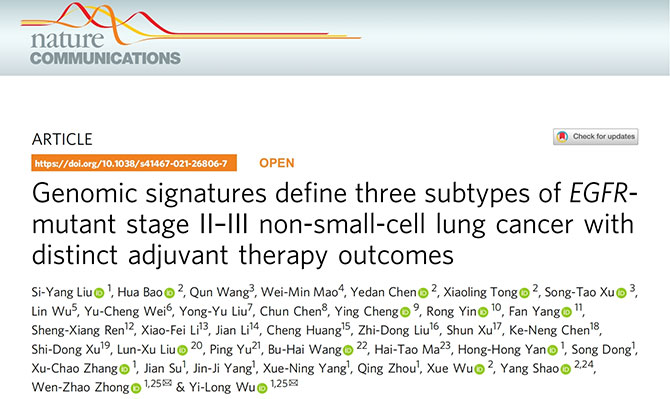

On November 8, 2021, Prof. Wu Yilong’s team published the MINERVA precise measurement of postoperative personalized adjuvant therapy strategy for the EGFR-mutant lung cancer on Nature series—Nature Communications. The first author of this article is Dr. Liu Siyang from the Department of Pulmonary Surgery, and the corresponding authors are Prof. Wu Yilong and Prof. Zhong Wenzhao of Guangdong Provincial People’s Hospital.
Dr. Liu Siyang is a winner of our hospital’s Double-Youth Talent Program and the Seedling Project of the Summit Program, and was chosen as an excellent young talent in 2021.

This article provides reasonable and feasible guidance towards personalized adjuvant therapy. Young physicians from the Guangdong Lung Cancer Institute has been making in-depth explorations in precise lung cancer diagnosis and treatment under the leadership of Prof. Wu Yilong and with the support of the high-level hospital construction program and Double-Youth Talent Program of Guangdong Provincial People’s Hospital to provide lung cancer patients with the best medical services, showing the prominent position of Guangdong Provincial People’s Hospital in the field of oncological diagnosis, treatment and research.
Prof. Wu Yilong’s comment on Minerva
The Minerva study is a derivate of the CTONG1104-ADJUVNAT study series, and opens a new door to personalized adjuvant therapy with higher precision on the basis of the four original studies of this series, namely disease-free survival-DFS (JCO), relapse mode (JTO), overall survival OS (JCO), and living quality (Lung Cancer).
In 2017 and 2020, CTONG1104 was reported at annual meetings of the American Society of Clinical Oncology (ASCO) for its leading design philosophy and perfect implementation, conforming that as a postoperative adjuvant targeted drug for lung cancer, gefitinib could extend DFS and reduce relapse risk by around 40%, and had an overall survival close to that of the standard adjuvant chemotherapy, and a five-year survival rate of around 52% – an increase of nearly 10% compared to more than a decade ago when the adjuvant chemotherapy was the standard. That’s a great achievement!
However, for some patients with driver mutation, targeted therapies are still not as effective as the chemotherapy. Why? The population must be further divided!
The team of the Guangdong Lung Cancer Institute and CTONG explored the secret on the gene level by setting rigorous data and validation sets, and going deep into the micro-world of tumor issues together with 27 centers nationwide and scientists at Geneseeq. They found that all postoperative lung cancer patients could be divided into three subgroups – Highly TKI-Preferable (accounting for 35% of the study population), TKI-Preferable (51%), and Chemotherapy-Preferable groups (14%). Compared to the adjuvant chemotherapy, for the Highly TKI-Preferable group who took gefitinib, the death risk was reduced by 79%, the median survival time has not been reached, and the five-year survival rate was close to 70%! The five-year survival rate of Chemotherapy-Preferable group also reached 62%, higher than 28% for targeted therapies! The results of TKI-Preferable group were consistent with that of the whole population, with the relapse risk reduced by 39% and the five-year survival rate being about 60%.
Destiny has its internal causes. The secret of Minerva is finally unveiled – five genes play a vital role. The first is RB1. Once it appears, a targeted therapy will become ineffective quickly or even useless, and lung cancer is likely to be converted into small cell lung cancer, for which a chemotherapy is essential. The second one is the well-known TP53, which has tens of mutations. TP53 exon4/5 mutations are discovered in this study, and indicate an inclination to the targeted therapy and resistance to chemotherapy. How amazing. So please don’t associate TP53 directly with chemotherapy any more! The other three genes, NKX2-1, CDK4 and MYC, exist in an amplified form, and are resistant to chemotherapy more or less without affecting targeted therapy. The combination of these five genes can further categorize patients precisely to realize truly precise treatment.
Liu Siyang, Gan Bin, Zhong Wenzhao